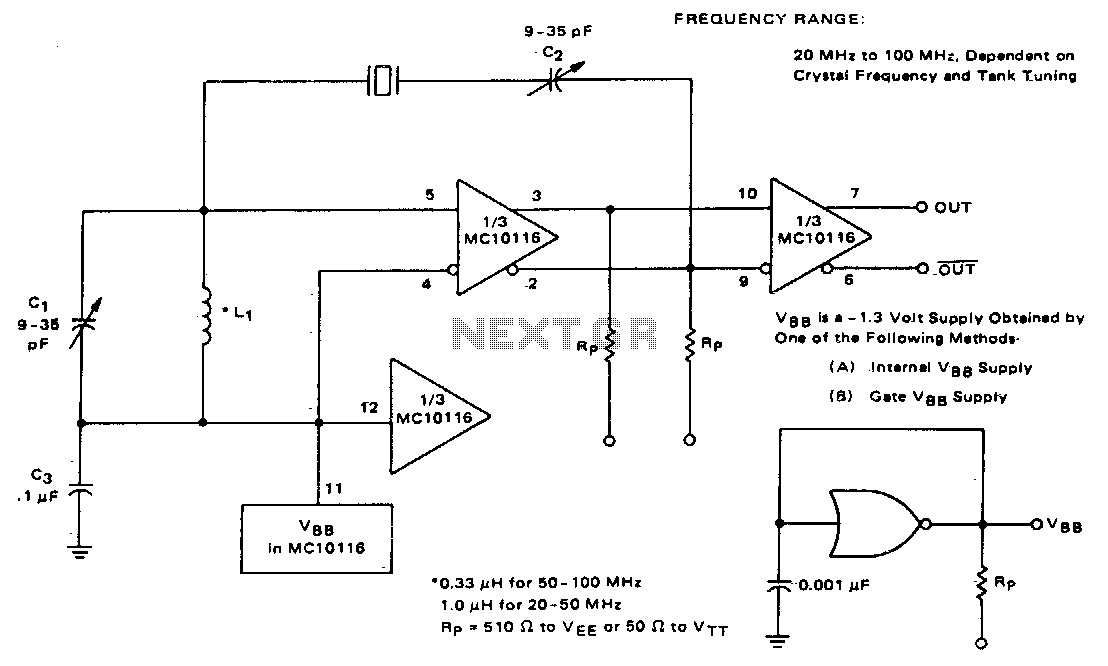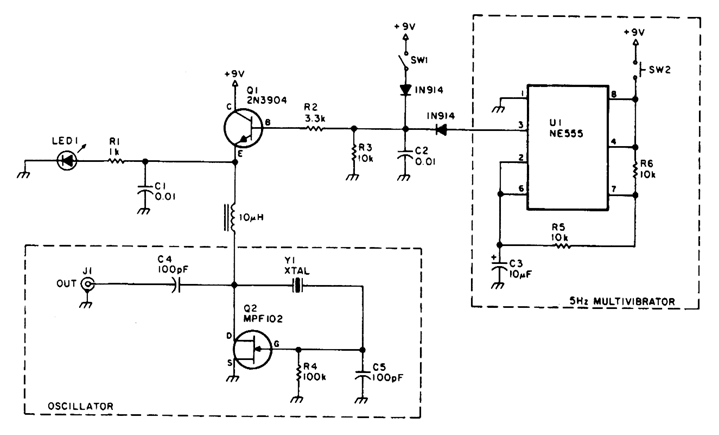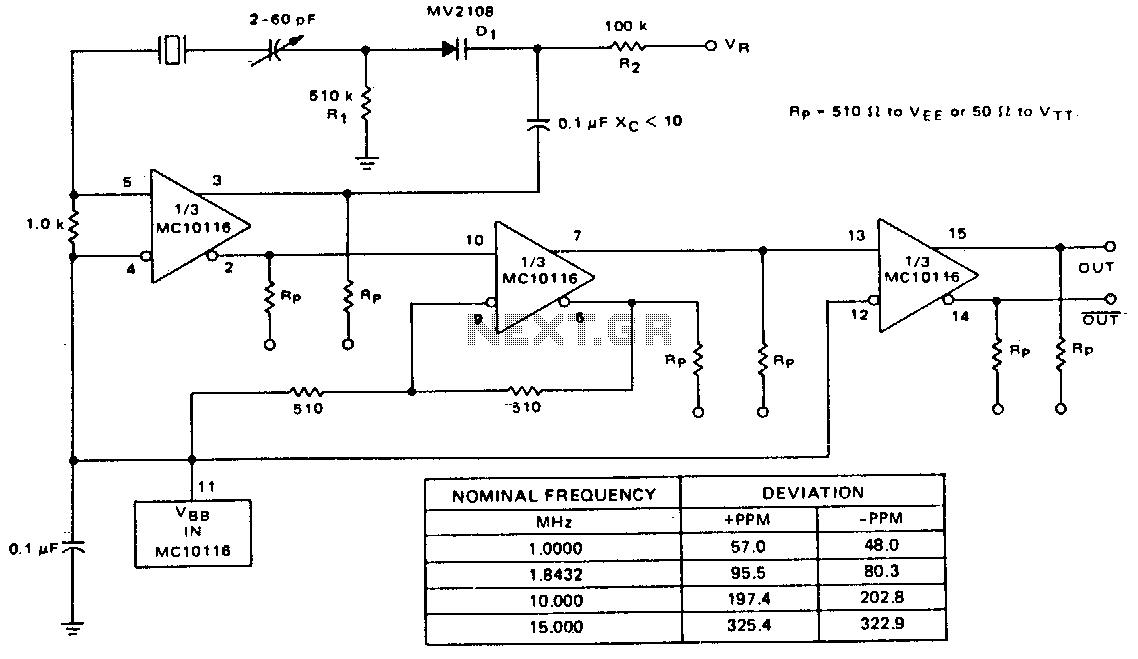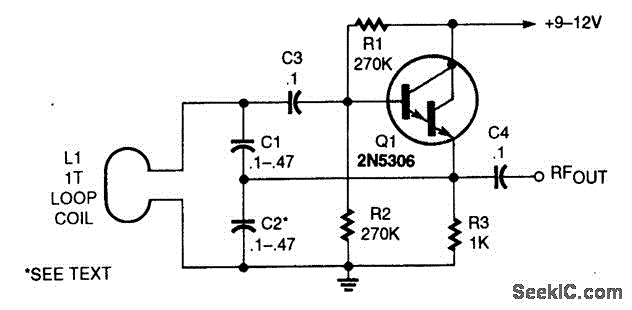
Overtone crystal oscillator

This circuit utilizes an adjustable resonant tank circuit that ensures operation at the desired crystal overtone. Capacitor C1 and inductor L1 form the resonant tank circuit, which can be adjusted to achieve a resonant frequency ranging from approximately 50 MHz to 100 MHz. Overtone operation is achieved by tuning the tank circuit frequency to be at or near the desired frequency. The tank circuit presents a low impedance shunt to off-frequency oscillations while maintaining a high impedance to the desired frequency, thereby facilitating feedback from the output. This operational method guarantees that the oscillator will consistently initiate at the correct overtone.
The described circuit features a resonant tank circuit composed of a capacitor (C1) and an inductor (L1), which are configured to create a tunable resonant frequency. This design is particularly advantageous for applications requiring precise frequency control, such as in radio frequency (RF) oscillators or signal generators. The adjustable nature of the tank circuit allows for fine-tuning of the resonant frequency, which is critical for achieving optimal performance across the specified frequency range of 50 MHz to 100 MHz.
In practical terms, the adjustment mechanism might involve variable components, such as a variable capacitor or an adjustable inductor, which can be tuned to achieve the desired overtone frequency. The circuit's ability to provide low impedance to off-frequency signals while presenting high impedance to the target frequency is essential for maintaining stability and ensuring that the oscillator operates effectively at the intended overtone. This impedance behavior enhances the feedback loop, allowing the oscillator to sustain oscillations at the desired frequency without interference from unwanted harmonics or noise.
Furthermore, the design of the tank circuit is crucial in determining the quality factor (Q) of the oscillator, which directly influences the bandwidth and stability of the generated signal. A higher Q factor implies a narrower bandwidth and improved selectivity, making it ideal for applications where signal integrity is paramount.
Overall, this adjustable resonant tank circuit is a vital component in achieving reliable and stable operation of crystal oscillators, ensuring that they function correctly across a range of frequencies while minimizing the impact of off-frequency disturbances.This circuit employs an adjustable resonant tank circuit which insures operation at the desired crystal overtone. Cl and LI form the resonant tank circuit, which with the values specified as a resonant frequency adjustable from approximately 50 MHz to 100 MHz.
Overtone operation is accomplished by adjusting the tank circuit frequency at or near the desired frequency The tank circuit exhibits a low impedance shunt to off-frequency oscillations and a high impedance to the desired frequency, allowing feedback from the output. Operation in this manner guarantees that the oscillator will always start at the correct overtone. 🔗 External reference
The described circuit features a resonant tank circuit composed of a capacitor (C1) and an inductor (L1), which are configured to create a tunable resonant frequency. This design is particularly advantageous for applications requiring precise frequency control, such as in radio frequency (RF) oscillators or signal generators. The adjustable nature of the tank circuit allows for fine-tuning of the resonant frequency, which is critical for achieving optimal performance across the specified frequency range of 50 MHz to 100 MHz.
In practical terms, the adjustment mechanism might involve variable components, such as a variable capacitor or an adjustable inductor, which can be tuned to achieve the desired overtone frequency. The circuit's ability to provide low impedance to off-frequency signals while presenting high impedance to the target frequency is essential for maintaining stability and ensuring that the oscillator operates effectively at the intended overtone. This impedance behavior enhances the feedback loop, allowing the oscillator to sustain oscillations at the desired frequency without interference from unwanted harmonics or noise.
Furthermore, the design of the tank circuit is crucial in determining the quality factor (Q) of the oscillator, which directly influences the bandwidth and stability of the generated signal. A higher Q factor implies a narrower bandwidth and improved selectivity, making it ideal for applications where signal integrity is paramount.
Overall, this adjustable resonant tank circuit is a vital component in achieving reliable and stable operation of crystal oscillators, ensuring that they function correctly across a range of frequencies while minimizing the impact of off-frequency disturbances.This circuit employs an adjustable resonant tank circuit which insures operation at the desired crystal overtone. Cl and LI form the resonant tank circuit, which with the values specified as a resonant frequency adjustable from approximately 50 MHz to 100 MHz.
Overtone operation is accomplished by adjusting the tank circuit frequency at or near the desired frequency The tank circuit exhibits a low impedance shunt to off-frequency oscillations and a high impedance to the desired frequency, allowing feedback from the output. Operation in this manner guarantees that the oscillator will always start at the correct overtone. 🔗 External reference





